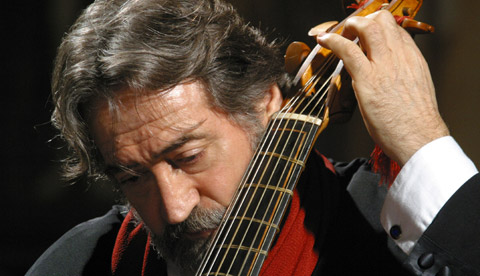
JORDI SAVALL |
"The Celtic Viol" — the title of the Boston Early Music Festival concert Catalan gambist Jordi Savall gave yesterday evening at Jordan Hall — looks like an oxymoron, since Irish and Scottish music is almost by definition traditional and popular and the viol is associated with "serious" early classical music. But Savall has a history of making unlikely connections, and as a member of a minority community in Spain, he's always been interested in the music of other minorities, like the Spanish Jews and the French Cathars. Over the past few years, his Alia Vox label has released The Celtic Viol and The Celtic Viol II, and the title of his program note (drawn from his liner note to The Celtic Viol) is "In Praise of Transmission," an homage to music (and the performance tradition that accompanies it) that's passed on from one musician to the next rather than being ossified as a score.
At Jordan Hall, he turned up with two instruments: a six-string treble viol dating from 1750 and a seven-string lyra viol that he could tune to suggest, among other things, a bagpipe. He was joined by BEMF artistic co-director Paul O'Dette on lute and cittern (was that a black-and-gold tie O'Dette was wearing in tribute to the Stanley Cup–winning Bruins?) and Shane Shanahan on bodhrán. The only lighting on stage came from directly overhead — was the idea that Savall and company were getting divine inspiration, or was this someone's notion of the Celtic Twilight? The program, all of it drawn from the two CDs, was divided into five groups of related tunes: the Caledonia Set, the Lord Moira's Set, the Lamento Set, the Lancashire Pipes Set, and the Donegal Set.
Savall played treble viol in the odd-numbered sets and lyra viol in the evens. The treble was fiddle-like, but deeper and richer; the lyra had the grit of a cello but was nimbler. The lyra has a flatter bridge than other viols, so it's possible to play chords. In his solo Lord Moira's Set, Savall used "Regents Rant" to explore the resources of his instrument, building to an agitated frenzy; then he turned humorous, his little suspensions in "Lord Moira's Hornpipe" affording room for a dancer's virtuoso footwork. For the Lancashire Pipes Set, he was joined by Shanahan, and in "The Lancashire Pipes," you could hear the drone.
His treble sets were sweeter, but the tunes emerged less bright and sharp than they would have from a fiddle, a sober sound for peoples with a sobering history. "Caledonia's Wail for Niel Gow" fluttered in its ornamentation, and "Sackow's Jig" was a footstomper, but it was the airs that haunted: "Lament for the Death of His Second Wife," "The Rover Reformed" (and sounding rather wistful about it), "Carolan's Farewell" (which ended with a feathery sigh), and the first encore, Charlie Hunter's "The Hills of Lorne." O'Dette and Shanahan accompanied with great discretion, O'Dette playing mostly the cittern when Shanahan sat in and the lute when he did not. The jig closer, "Gusty's Frolics," stopped just when it seemed the imaginary dancers — and the audience — were getting warmed up. That was also true of the last encore, "Peter's Peerie Boat." Only when Savall looked at his watch did people remember that the next concert was to start at eight and they had only an hour and a quarter in which to get dinner.